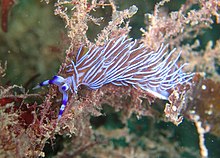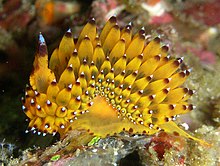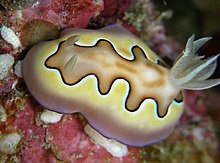Nudibranch
| Nudibranch | ||||||||||||
|---|---|---|---|---|---|---|---|---|---|---|---|---|

The 43rd panel of Ernst Haeckel's Kunstformen der Natur (1904) depicts some types of nudibranchia |
||||||||||||
| Systematics | ||||||||||||
|
||||||||||||
| Scientific name | ||||||||||||
| Nudibranchia | ||||||||||||
| Blainville , 1814 |

The nudibranch (Nudibranchia) are the largest suborder of the hind-gill snails . The suborder includes more than 3000 species of nudibranchs that live in the sea.
construction
In the nudibranch snails, the mantle cavity , shell and foot flaps are missing . Breathing occurs through the skin or through a kind of gill structure on your back, the so-called cerata. Runners of the midgut glands also move into this cerata and in the aeolidioidea , which feed on hydroid polyps, the nettle capsules are shifted through the midgut gland into the cerata, where they are stored and can be used for defense. These nettle capsules are now called kleptocnids (see protective mechanisms).
Their size varies between 4 mm and 60 cm. They occur worldwide in all depths of the sea and are among the most colorful animals on earth. They usually have a pair of antennae on their head and various tentacles - or feather-like attachments. The feelers, called rhinophores , contain chemical sensory organs and are primarily used for flow perception. Further tentacle appendages in the mouth area are responsible for further sensory functions such as touch, taste and smell. The eyes are deep under the skin near the brain ganglion. With their help, only light-dark distinctions can be perceived, e.g. B. the shadow of an enemy or the rhythm of the times of the day.
The nudibranchs are hermaphrodites , but cannot fertilize themselves. They lay their eggs in ribbon-shaped spiral egg packages.
Nudibranchs can be found at all depths of the sea, but most forms exist in warm seas in shallow water areas.
Protection mechanisms
The nudibranchs have lost their protective housing in the course of evolution and have developed other defense mechanisms.
- The coloring serves as camouflage in some species , which is reinforced by feather-like and tuft-like appendages, so that they are difficult to distinguish from plant structures. In addition, the different color components of the light are absorbed differently in different water depths. Colors that appear conspicuous on the water surface (e.g. red) can act like camouflage colors at a certain depth, as only their green and blue components are reflected. It is difficult for divers to find the otherwise conspicuous snails in appropriate surroundings.
- In the case of other nudibranchs, the conspicuous coloration serves as a warning of their toxicity or inedibility; one then speaks of aposematism . Some species secrete toxic secretions on their skin. The various attachments and tentacles can easily be regenerated if lost.
- The snails, which feed on the polyps of the cnidarians , can store the stinging cells in the skin of their abdomen, where they can lead to unpleasant experiences in predators. The stinging cells pass through the digestive tract undamaged and are brought to the appropriate places in the abdomen through special intestinal protuberances. The nudibranch themselves have developed defense mechanisms against the nettle attack by the polyps. Special cells with large vacuoles in the skin probably play a role here. One speaks of sequestration .
- Another defense against mechanical irritation is the excretion of acid mucus from the skin cells.
nutrition
Nudibranchs feed on sessile invertebrates such as sponges , hard or soft corals , crusty anemones or bryophytes . The specialization often goes so far that only a certain species is eaten. Some species eat other nudibranchs, in some cases even weaker specimens of their own species. One group specializes in tunicates .
Systematics
According to the modern snail system by Ponder & Lindberg (1997), nudibranchs comprise eight superfamilies in two subgroups:
- Anthobranchia Férussac, 1819
- Superfamily star snails (Doridoidea) Rafinesque, 1815
- Neon star snails (Polyceridae) Alder & Hancock, 1845
- Magnificent star snails (Chromodorididae)
- Spanish dancers (Hexabranchidae)
- Wart snails (Phyllidiidae) Rafinesque, 1815
- Superfamily Doridoxoidea Bergh, 1900
- Superfamily Onchidoridoidea Alder & Hancock, 1845
- Onchidorididae Gray, 1854
- Soft waxy star snail ( Acanthodoris pilosa )
- Brown-spotted warthog ( Onchidoris bilamellata )
- Onchidorididae Gray, 1854
- Superfamily Polyceroidea Alder & Hancock, 1845
- Polyceridae Alder and Hancock, 1845
- Faroese squirrel snail ( Polycera faeroensis )
- Striped squirrel snail ( Polycera quadrilineata )
- Polyceridae Alder and Hancock, 1845
- Superfamily star snails (Doridoidea) Rafinesque, 1815
- Cladobranchia Willan & Morton, 1984
- Superfamily sapling snails (Dendronotoidea) Allman, 1845
- Shaggy tree snail ( Dendronotus frondosus )
- Superfamily furrows screw (Arminoidea) Rafinesque 1814
- Superfamily Metarminoidea Odhner in Franc, 1968
- Superfamily thread snails (Aeolidioidea) JE Gray, 1827
- Aeolidiidae
- Breitwarzige thread snail ( Aeolidia papillosa )
- Drummond's thread snail ( Facelina bostoniensis )
- Flabellinidae
- Milky thread snail ( Flabellina pellucida )
- Flabellina affinis ("violet thread snail")
- Flabellina pedata (" Red-violet thread snail ")
- Flabellina goddardi
- Notaeolidiidae
- Notaeolidia depressa Eliot, 1907
- Glaucidae
- Aeolidiidae
- Superfamily sapling snails (Dendronotoidea) Allman, 1845
literature
- Hans A. Baensch / Robert Patzner: Mergus Sea Water Atlas Volumes 2, 4 + 5, Mergus-Verlag, Melle
- SA Fosså, & AJ Nilsen: Coral Reef Aquarium , Volume 5, Birgit Schmettkamp Verlag, Bornheim, ISBN 3-86659-014-8
- KORALLE, marine aquaristic specialist magazine, No. 26 April / May 2007, Natur und Tier Verlag Münster, ISSN 1439-779X
- Helmut Debelius , Rudie H. Kuiter , Nudibranchs of the World, Kosmos Verlag, ISBN 978-3-440-11133-8
Web links
- Nudibranchs from Indonesia, the Philippines and Thailand
- The Sea Slug Forum - excellent site on the topic
- The Sea Slug Watchers - Japanese / English language site with lots of excellent photos
- www.seaslugs.de - Webpage with numerous pictures on the subject of nudibranchs (German)





